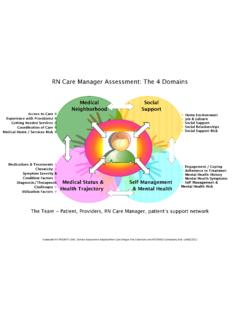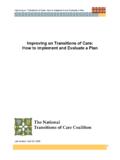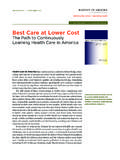Transcription of Complex Care Management Toolkit - calquality.org
1 Complex care Management Toolkit Introduction The following document is a guide to improving and implementing a Complex care Management program for individuals with multiple chronic conditions, limited functional status, and psychosocial needs, who account for a disproportionate share of health care costs and utilization. This Toolkit summarizes ideas to improve an existing Complex care program, or implement a new one. In the document, there are links to numerous resources and tools that you can adapt as you build or test changes for your program. The following graphic provides an example of where a Complex care Management program might fit in your organization, as it relates to other efforts for population, disease or case Management . TABLE OF CONTENTS. Getting Started .. 2. Patient Identification .. 4. and Risk Stratification The changes suggested in this change package were gleaned from a variety of sources: Learning from a 12-month Complex care Management Action Community, funded by the Complex care Management .
2 6. California HealthCare Foundation (CHCF) The Action Community convened eight California Model Design organizations that are working to redesign and improve care for their Complex patients. Its purpose was to: 1) facilitate peer learning among the organizations so that they could learn care Manager and care Team Roles .. 9. about, share, and test improvements in Complex care ; and 2) develop this Toolkit based on the and Training learning from these organizations Physician and Office .. 10 Feedback from experts in the field Staff Engagement Evidence-based practices cited in the literature Patient Engagement .. 11 We hope you find this resource helpful. We would appreciate hearing from you about your experience using this guide in an effort to improve its use across organizations. Please contact Measurement Plan .. 13 CQC with suggestions, comments or questions: Giovanna Giuliani or 415/615-6377. Director, California Quality Collaborative If you've received a paper version of this Toolkit , please visit our website ( ) to download an electronic version, which will allow you to access all of the links to the resources within the Toolkit .
3 Complex care Management | April 2012 1. Getting Started As you get started, ask these important questions to determine if you can/should move forward Good foundational resources with developing a Complex care Management program: Robert Wood Johnson Foundation: The Can the organization articulate the purpose of a Complex care program? How the program Synthesis Project. care Management of would help physicians and patients? patients with Complex health care needs. What is the business case behind improving care for high-risk patients? For example, does Several summary documents can be found your group accept full-risk for patients or are there Management fees or shared savings here. dollars available? The Promise of care Coordination: Models Is the organizational leadership engaged as evidenced by the commitment of financial and that Decrease Hospitalizations and Improve staff resources? Outcomes for Medicare Beneficiaries with Can you identify your target population (both who you would start with and ultimately who Chronic Illness.)
4 A Report Commissioned you would like to serve)? What data do you have that can help you identify and stratify your by the National Coalition on care high risk population (utilization, diagnoses, pharmacy data, etc.)? Coordination. By Randall Brown, PhD, Is there adequate capacity within primary care and disease case Management within your Mathematica Policy Research. organization so that patients can graduate out of high-risk programs , when appropriate? IHI White Paper on care Coordination Are physicians engaged and do they understand the program? (proxy: if you ask physicians Model: Better care at Lower Cost for People what the intervention is, can they describe it and do they visibly support it?). with Multiple Health and Social Needs Are patients involved in the design of the program? Is there a process in place to get Summary and evaluation of Boeing's feedback from patients and their families/caregivers on an ongoing basis? Intensive Outpatient care Program (IOCP) in Are the practice site and facility leadership involved and engaged do they buy in?
5 The Puget Sound area in Washington. Health Are the necessary partners aligned, such as payers, hospitals, and specialists? Do you have Affairs Blog. what you need from these partners, such as data or a process for data flow? Evolution of Complex care programs from Do you have a data measurement plan in place to measure effectiveness of the program? the California Improvement Network 2 April 2012 | Complex care Management Getting Started Step-by-Step Define the business case for your organization. Starting as a Pilot What are the clinical and organizational problems that you are trying to solve? The business Start the program as a pilot, with engagement case will vary by business line: Medicare Advantage? Accountable care Organization (ACO)? How will you know if you are solving them ( , lower rates of emergency department use or of a limited number of physicians and patients. hospital admission)? This approach enables the following: Rapid testing and process development Identify patients.
6 Work with a health plan partner that can identify candidate patients via a Relationship development and identification predictive risk tool, then refine the patient list based on clinical input, functional status, patient activation and social support. If you do not have a health plan partner, try a simple risk algorithm and engagement of program/clinical using existing data, then refine the patient list in the same manner. Start small, with 10 patients for example. Knowing who your target patients are will likely inform your initial care model design champions . and target practice sites. Refinement at small scale Starting with a sub-population the Determine the care model. Consider existing resources and staff. For example, it may be easiest to start with an existing, centrally located care manager who is accustomed to working with organization, payers, providers, and partner more Complex cases, and with 1-2 practice sites where you have physician buy-in.
7 Organizations care about as a way to engage and build interest Define care manager role and provide training. Slowly ramp up the responsibilities and Making an informed decision about spread caseload of the care manager over time, starting off with recruitment phone calls, transitioning to intake visits and assessments, and eventually to independently managing a panel of patients. Develop a plan for training that includes shadowing internal experts, 1:1 mentoring, motivational interviewing and care transitions support training within the first several months. Recruit and enroll patients. An initial call from the PCP's office staff, followed by a letter on physician office letterhead, then followed by a call from the care manager or an enrollment specialist to enroll the patient is a good starting point for your process. Engage patients by asking them for feedback on the recruitment and enrollment process so you can refine over time.
8 Intake, assess and stratify. Develop an initial intake and assessment process that includes establishing an initial care plan and goals and identifying any critical care needs. Consider having the initial visit face-to-face to build trust between the patient and care manager. Provide support and interventions through your care team: Ongoing outreach and care coordination care transitions support Patient engagement and activation Case conferences Ongoing communication with PCP. Create a systematic approach to identify, assess, and engage larger numbers of patients and providers. Expand your program by adding targeted subsets of patients and engaging practice sites or providers that are receptive. Measure and continually adapt/improve the approach. Set up a measurement plan early in the process. Refine your approaches, tools, and processes on an ongoing basis. Throughout the process above: Engage leadership, physicians, staff and patients in the planning process through rapid testing Complex care Management | April 2012 3.
9 PAT I E N T I D E N T I F I C AT I O N A N D R I S K S T RATIFICATION. CHANGES TO TRY: RESOURCES: Develop an initial algorithm or set of criteria to identify candidates for your high- Tip sheet for identification of high-risk risk/ Complex care program. If your organization has access to claims data, there are several patients off-the-shelf claims-based tools that produce a prospective risk score based on some combination Examples of tools: of the following: demographics, utilization, diagnoses, medication/prescription fill information, Risk stratification tool (CalOptima). existence of co-morbidities, and previous costs. These tools provide objective, replicable methods, Identification and stratification tool but are imperfect; therefore, it is important to refine the list of identified patients using other (MemorialCare). inputs (see below for stratification ideas). Vulnerable Elders Survey (VES-13). In the absence of claims data, see the tip sheet on the right for a starter set of variables to instrument and information use in the development of a risk algorithm a basic list should include age, hospital/emergency Predicting the Financial Risks of department utilization, volume of medications, and key diagnoses.
10 Seriously Ill Patients by Stuart Levine, Keep in mind: MD et al (paper published on the CHCF. website). No approach/algorithm will be perfect start simple with the data you have readily available, or by building a panel through PCP or post-discharge referrals only Looking at the data coupled with clinical review ( care team reviewing charts, PCP clinical assessment, or asking the PCP) seems to yield the best results (see stratification tips below). There will be high-risk patients who are not identified using your approach use multiple methods to identify high-risk patients to help mitigate this risk Other methods include: direct referrals from PCP, disease case managers, or health plans; or identification at significant care transitions There will be patients identified by your approach who do not need a high-risk intervention . further stratification and assessment should help to make these distinctions. Once candidates for a high-risk program are identified, stratify them into different levels of Examples of tools: interventions and outreach intensity by one or more of the following: Assessment and stratification tool (Humboldt).







